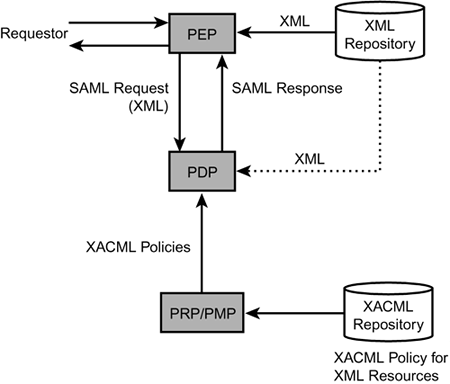eXtensible Rights Markup Language (XrML) Management Specification
| < Day Day Up > |
| The eXtensible Rights Markup Language specifies rights to control access to digital content and services. XrML is part of the effort to create an infrastructure to manage digital rights on copyright and for-fee content that is moved across the public networks. XrML is a rights language that supports a wide variety of business models from free content that still must control who accesses it (for example, real estate home listings) to valuable content that must be purchased by the end user (for example, digital music). It can specify simple and complex rights. It is designed to handle any type of digital content or service. It gives precise meaning to all components of the system. A couple of its critical early design goals were that it be interoperable with other standards and specifications and that it be platform neutral. The XrML Data ModelThe data model for XrML consists of four entities and the relationship between those entities. The most important relationship is the XrML assertion Grant. A Grant is structured as follows :
A Principal is an individual who must present identification credentials such as an X.509 certificate or a digital signature. If the authentication of this individual is successful, that person may be granted some Rights to the digital content. The Right is a verb that a Principal can be granted to exercise agaist some content. For example, the Right might be to read, view, print, forward, or even grant rights to others. The Resource is the object to which a Principal can be granted a Right. It might be an e-book, an audio or video file, or an image. It can also be a service such as email or a Web service. A Condition specifies the terms, conditions, and obligations under which the Rights can be exercised. This might be a time interval, or it might require that someone else has also granted some Rights first, such as a trusted third party. The relationships of the four key XrML constructs are shown in Figure 9.10. Figure 9.10. Core XrML constructs and their interrelationships. XrML Use Case ExampleThe following use case illustrates how to use XrML in a service-centric business model, which focuses on specifying Rights, Conditions, and metadata for services, such as Web services. In this use case, Alice pays $2 each time she uses a Web service to receive stock quotes. Figure 9.11 illustrates this use case. Figure 9.11. Alice may use the content from a Stock Quote Web service if she pays $2 for such use. To specify this information in XrML, you need to
Figure 9.12 illustrates the structure of Alice's license. Figure 9.12. The XrML license for Alice's use case. The license in Listing 9.12 illustrates how Alice's right to use a stock quote service subject to a fee could be expressed in XrML. In this example, the prefix sx: identifies elements from the standard extension. The prefix service: identifies elements from the sample service extension. The prefix stocks: refers to the WSDL definition namespace. The prefix dsig: refers to the namespace that defines XML signatures. All other elements are defined in the XrML core. Listing 9.12. XrML Specifying Alice's Rights to Use a Fee-Based Stock Quote Service<license> <grant> <!- - Alice is represented as the holder of a particular key - -> <keyHolder licensePartId="Alice"> <info> <dsig:KeyValue> <dsig:RSAKeyValue> <dsig:Modulus>4hre4NP7R...</dsig:Modulus> <dsig:Exponent>AQABAA==</dsig:Exponent> </dsig:RSAKeyValue> </dsig:KeyValue> </info> </keyHolder> <!- - Alice is granted the right to use the stock quote service - -> <service:use/> <!- - The stock quote service is represented with a service reference that contains a WSDL file - -> <serviceReference> <wsdl> <xml> <wsdl:definitions name="StockQuote" targetNamespace="http:// www.xrml.org/examples/2001/11/wsdl-stocks/stockquote.wsdl"> <wsdl:types> <xsd:schema targetNamespace="http://www.xrml.org/examples/2001/ 11/wsdl-stocks/stockquote.xsd"> <xsd:element name="TradePriceRequest"> <xsd:complexType> <xsd:all> <xsd:element name="tickerSymbol" type="xsd:string"/> </xsd:all> </xsd:complexType> </xsd:element> <xsd:element name="TradePrice"> <xsd:complexType> <xsd:all> <xsd:element name="price" type="xsd:float"/> </xsd:all> </xsd:complexType> </xsd:element> </xsd:schema> </wsdl:types> <wsdl:message name="GetLastTradePriceInput"> <wsdl:part name="body" element="stocks-xsd:TradePriceRequest"/> </wsdl:message> <wsdl:message name="GetLastTradePriceOutput"> <wsdl:part name="body" element="stocks-xsd:TradePrice"/> </wsdl:message> <wsdl:portType name="StockQuotePortType"> <wsdl:operation name="GetLastTradePrice"> <wsdl:input message="stocks:GetLastTradePriceInput"/> <wsdl:output message="stocks:GetLastTradePriceOutput"/> </wsdl:operation> </wsdl:portType> <wsdl:binding name="StockQuoteSoapBinding" type="stocks: StockQuotePortType"> <soap:binding style="document" transport="http:// schemas.xmlsoap.org/soap/http"/> <wsdl:operation name="GetLastTradePrice"> <soap:operation soapAction="http://example.com/ GetLastTradePrice"/> <wsdl:input> <soap:body use="literal"/> </wsdl:input> <wsdl:output> <soap:body use="literal"/> </wsdl:output> </wsdl:operation> </wsdl:binding> <wsdl:service name="StockQuoteService"> <wsdl:documentation>My first service</wsdl:documentation> <wsdl:port name="StockQuotePort" binding= "stocks:StockQuoteSoapBinding"> <soap:address location="http://example.com/stockquote"/> </wsdl:port> </wsdl:service> </wsdl:definitions> </xml> </wsdl> <service>stocks:StockQuoteService</service> <portType>stocks:StockQuotePortType</portType> </serviceReference> <!- - Alice pays .00 each time she exercises her right to use the stock quote service - -> <sx:fee> <sx:paymentPerUse> <sx:rate> <sx:amount>2.00</sx:amount> <sx:currency>US</sx:currency> </sx:rate> </sx:paymentPerUse> <sx:to> <sx:aba> <sx:institution>13937151</sx:institution> <sx:account>4281938823</sx:account> </sx:aba> </sx:to> </sx:fee> </grant> </license> The following are some XrML resources: http://www.oasis- open .org/ committees /tc_home.php?wg_abbrev=rights http://www.xrml.org/ http://xml.coverpages.org/xrml.html http://www.giantstepsmts.com/DRM%20Watch/xrml20.htm
|
| < Day Day Up > |
EAN: 2147483647
Pages: 119



